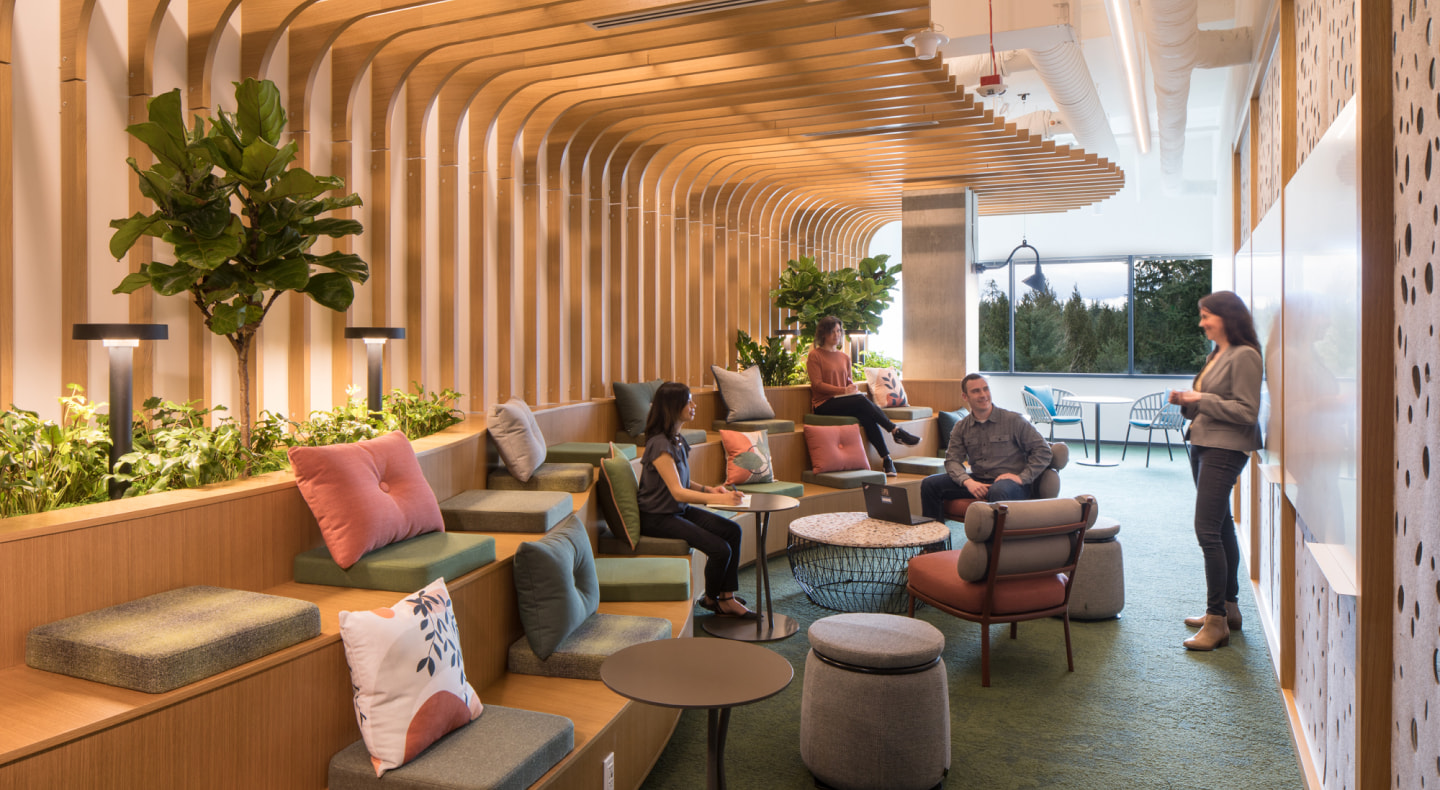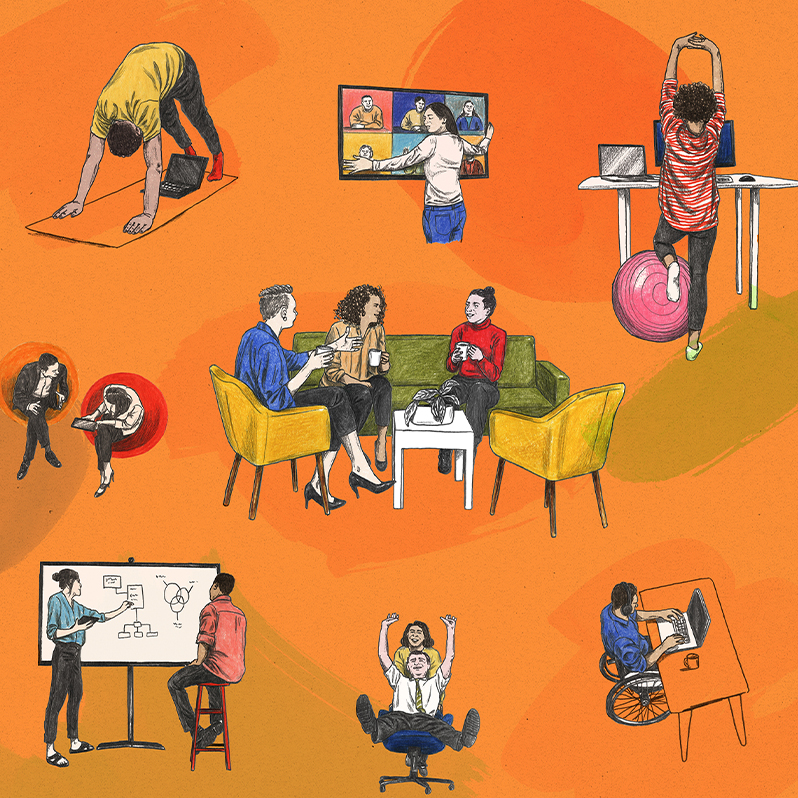
A traditional office, fundamentally, is a collaboration tool for getting work done. But even as our other collaboration tools have changed in this new world of hybrid work, this tool, too, needs to be redesigned and redefined to serve different needs. As we detail in our WorkLab Guide , physical work spaces are essential for functions like team building and bonding, establishing ties with other colleagues, connecting people to the company mission and culture, and more. But people are still learning how to use it in these new ways: when it comes to hybrid work, 38 percent of employees say their biggest challenge is knowing when and why to connect in person, according to the 2022 Work Trend Index report.
It’s up to leaders, then, to create an environment that people really love to work in, and that serves the needs of people who are in the room and people who are dialing in remotely: these spaces should be made different, better, more enticing, and more tuned to the ways people now work. This process can be iterative—it doesn’t have to happen all at once, for Microsoft or any other company, especially in a time of such rapid change—and it doesn’t have to be especially costly or require new construction in an unsteady economy that has a lot of leaders skittish about big spends.
To figure out how leaders can think about the physical spaces they have, and the spaces their teams will enjoy coming back to, WorkLab spoke to multiple architecture and design firms, including Steelcase, Gensler, and Herman Miller, along with design and real estate leaders at Microsoft. Four basic principles emerged: work spaces of the future should be flexible and hybrid-enabled, they should promote wellness and accessibility—and they should be delightful.
Sources for this story:
Ryan Anderson , vice president of global research and insights for Herman Miller
Robin Klehr Avia , Gensler’s regional managing principal for the Northeast
Cherie Johnson , design director at Steelcase
Mike Messer , a lead in Microsoft’s global digital transformation building efforts
John Scherer , Microsoft global workplace strategist
The Flexible Work Space
Open work spaces have a bad reputation—remember those rows of desks with no privacy? Some newly redesigned spaces are anything but exposed beige deserts, instead focusing on team-based work and “neighborhoods.” “It’s a misconception that a desk not enclosed by four walls is inherently open space,” says John Scherer , a Microsoft global workplace strategist. Team-based spaces should center on collaboration, driving innovation, and supporting activity-based work. What does that look like in practice? “An ecosystem of different space types that serve you for different activities when you need it,” Scherer says.
For example, flexible meeting rooms and workplace “neighborhoods” allow workers to collaborate in a way that best suits them and the task at hand. That might include focus rooms for small groups, designated spaces for heads-down work, or dedicated team spaces that can be adjusted as needed.
“Trying to prioritize mental health has surfaced, given the effects of working from home and the lack of connection people have had.”
“Building these spaces to be intuitive is really critical,” says Mike Messer , a lead in Microsoft’s global digital transformation building efforts. The challenge is that infinite flexibility often means workers don’t know how to arrange things—or that they’re even allowed to. Messer suggests letting people know what can be adapted and showing them options. “Create two or three designs of the space optimized for certain types of interactions—one for a team off-site, one for a brainstorming session, and so on,” he says. Labels or posters suggesting configurations and identifying what is moveable can be helpful.
And don’t forget the juice! Adding power towers or smaller, wireless power hubs that can be moved by hand means that furniture doesn’t have to be anchored to an outlet and workers can stay powered up, wherever they are.
When people are working outside the traditional 9-to-5 timeframe, and when they’re not sitting at the same desk every day, it’s important to have a system for employees to find each other. Microsoft’s employee app will soon let people see when colleagues and collaborators will be in the office, and also allow them to see where there’s free space on any given floor. “Ultimately, we’d like to do things like checking in and sharing your location,” Messer says. “If you found a great little spot and want to invite somebody to come and meet you there, you could send them a pin and they can navigate to where you are.”
Be Flexible
People should be able to reconfigure the environment—down to the location of the power supply
The Hybrid Work Space
No matter who is actually present in person, some individuals may frequently be remote and attend meetings via conference room screens. While that experience has historically not been so great, certain key fixes can help.
One important step: rethink where you install the cameras. “Make sure that the sight lines are clear, that you’re not getting that awkward view of the top of someone’s head,” Johnson says. Depending on the type of work, cameras may be at natural eye levels or different angles.
Be intentional about what technology needs to be in what kind of room—in a small conference room, one integrated camera and speaker/mic is fine. In a larger room, you want to make sure you have at least two speakers/mics. Really big rooms need ceiling-mounted speakers and mics. It’s important that the people in the conference room can be heard clearly, and a combination of digital screens and physical whiteboards enables a variety of collaboration and creative styles.
Another thing to rethink is the very shape of the table: gumdrop- or guitar pick–shaped tables work well for hybrid collaboration. Those attending in person can still gather around the table naturally, while all facing the camera and the screen with remote participants. “So they have that natural interaction with the remote participants, but also being at a nice angle to where they’re still facing each other in the room,” Messer says.
Be Hybrid
From sight lines to the shape of the conference table, every meeting should be able to incorporate people in the room and remote participants seamlessly
“We are taking a test-and-learn approach—incorporating our findings into new projects and pivoting when we get it wrong.”
The Accessible Work Space
More in-person time together means more opportunities for chance encounters and serendipitous conversations. Lobbies and multi-use spaces within a building should be welcoming and engaging. “Spaces like these can also serve multiple work modes, such as informal meetings, small conversations, and even focus work. It is also critical that we prioritize accessibility and inclusivity in their design,” Scherer says.
Accessibility in the design of physical spaces is usually associated with mobility, or perhaps vision or hearing disabilities, but it can include considerations about mental health, neurodiversity, and individual work styles. “Trying to prioritize mental health has surfaced, given the effects of working from home and the lack of connection people have had,” Scherer says. And accessibility upgrades benefit every employee. Doors that open automatically help people who are lugging heavy boxes or recovering from an injury, as well as people with permanent mobility impairments. Adjustable desks, spread-out spaces, and low-slung seating ensure that people using wheelchairs can easily navigate the work space; they also increase comfort and safety for everyone.

“We want to be able to provide spaces that are an escape to regather your thoughts, especially in light of different cognitive needs and neurodiversity,” Scherer says. These stalls can function for heads-down work or quiet, personal time.
The Delightful Work Space
In-person time is for working, yes, but also to chat informally with colleagues, build social capital, make friends, and maybe do something fun. That could even mean taking work outdoors: a few years ago, Microsoft opened three treehouse spaces at its headquarters. “We wanted to connect the indoors and outdoors, and we wanted to take conference rooms and put them outside in the trees,” as real estate chief Michael Ford put it. Not only are these spaces unique, they’re incredibly popular.
While not every organization will want an actual treehouse, other outdoor spaces—rooftops, balconies, courtyards, and more—can give employees a change of pace and a literal breath of fresh air.
Make It a Delight
From treehouses to yoga studios, work spaces can also be fun spaces
Ultimately, the goal should be enabling in-person connection while still allowing flexibility and choice, and that means leaders must be intentional around the who, when, and where of in-person gathering. Corporate work environments once solely provided a place for heads-down work and meetings, but now they must evolve to meet new expectations. “We are taking a test-and-learn approach,” Messer says, “incorporating our findings into new projects and pivoting when we get it wrong.” Business leaders will have to rewrite the rules for how space is used so it can flex as needs change and bridge the gap between the physical and the digital—making work spaces more useful and more delightful than ever before.

